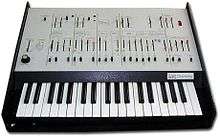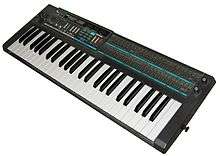Paraphony
Paraphony is a term used in musical vernacular to refer to consonances which rely upon intervals of fifths and fourths. This terminology can be traced to ancient Greece and sources such as Theon of Smyrna.[1]
Paraphony in electronic music
Completely unrelated to the above sense, a synthesizer is called paraphonic if it can play multiple pitches at once, but those pitches share part of their electronic signal paths.[2] For example, the Roland RS-202 string machine could play several dozen pitches at once, but only with a single shared volume envelope, requiring the collective chord to swell and diminish as a single cohesive whole. Similarly, the Korg Poly-800 had 8 oscillators and could produce 8 voices, but had just one filter circuit shared by all of them. Other examples include the Roland VP-330 vocoder and the Moog Sub 37.


References
- pg. 417 of "Apollo's Lyre: Greek Music and Music Theory in Antiquity and the Middle Ages" By Thomas J. Mathiesen, published by U of Nebraska Press
- "Polyphony, Paraphony and Multitimbrality". 2015-01-08.

